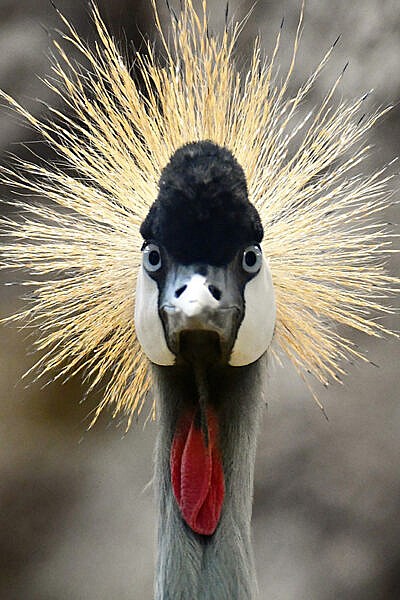In its third consecutive year of Cheyenne Mountain Zoo members’ support, International Crane Foundation’s work to save crowned cranes in East Africa is gaining momentum. The project, based in Kenya, is critical in understanding why wild crowned crane populations have declined by more than 80 percent in 25 years.

“We have to learn why something is happening before we can intelligently change that course,” said Philip Waugh, lead keeper in Water’s Edge: Africa. Waugh, along with his team, cares for Inzi and Tagi, CMZoo’s two East African crowned cranes. He first championed this conservation project in March 2020. “I hope our members know what a huge impact they’re making for these incredible birds. This research wouldn’t be possible without our members.”
A vital element of the project, led by International Crane Foundation (ICF), in partnership with Endangered Wildlife Trust, is identifying individual cranes. The team locates crane nests, and once the fledglings are born, they apply a combination of color-coded bands to the chicks’ legs. Then the researchers track them as they grow up and compare data to see why some populations survive and others don’t.
Thanks to knowledge gained since beginning this project in 2020, ICF now believes there is a significant gap in the number of juvenile birds surviving to adulthood. Cranes seem to hatch and fledge at a healthy rate, but far fewer than expected make it to mature adulthood. Identifying what threats these juvenile birds face, and helping them survive to breeding age, could be the key to saving this species.
“Once a crane reaches maturity, its plumage doesn’t change, and there are no obvious visual indications of age,” said Waugh. “We could think we see a healthy flock of cranes, but they could all be well beyond breeding age. We need to know why one population of cranes is living into its late twenties, while another population isn’t surviving to adulthood.”
Each colored band on a bird’s leg tells an important piece of its story. One band indicates its country of origin, another defines where it was banded, and another specifies when it was born. We will learn a lot about which waterways the cranes depend on, how many offspring each crane typically contributes to a population, how they prefer to roost and their movement patterns.

The team is covering a lot of ground, and learning a lot about crowned cranes. In 2020, the team banded 48 chicks. In 2021, they banded 79. In the last year, they also banded a clutch of four chicks. Most crowned cranes lay 1-2 eggs per clutch. There are fewer than ten records of a group of eggs this large ever documented in Kenya. More great news, all four chicks in that family survived and were banded! Researchers also observed the first-ever recorded instance of East African (also known as Grey) crowned cranes nesting in a tree.
“They’ve been wanting to start this fieldwork for more than a decade, so when they learned our members could potentially support it, they were excited and so were we,” said Waugh. “It’s inspiring to see how ICF and our members have prioritized this project. It goes to show that just by being a member at CMZoo, you can make big impacts for conservation around the world. Our members have allowed an organization with a presence on multiple continents to focus a lot of energy on this one project.”
A vital piece of any conservation success is local community support. In their recent report, ICF said they have been encouraged by local support for the banding project. Community members have been helping conservationists by reporting sightings of the birds. They attribute this positive community response to increased community engagement.
Every membership and every visit to CMZoo are conservation in action. Since 2015, the Member Conservation Vote has provided $525,000 of membership revenue to support field conservation worldwide. Each year, a total of $100,000 of membership revenue is contributed to conservation in two ways:
- $25,000 to the Quarters for Conservation program, which in total contributes half a million dollars on average annually to CMZoo’s legacy conservation partners
- $75,000 to projects voted for by CMZoo members through the annual vote
Last week, CMZoo members voted to decide how each of seven nominated conservation projects will be funded in 2022, including a continuation of this effort to save East African crowned cranes. Stay tuned for the results, coming soon!

